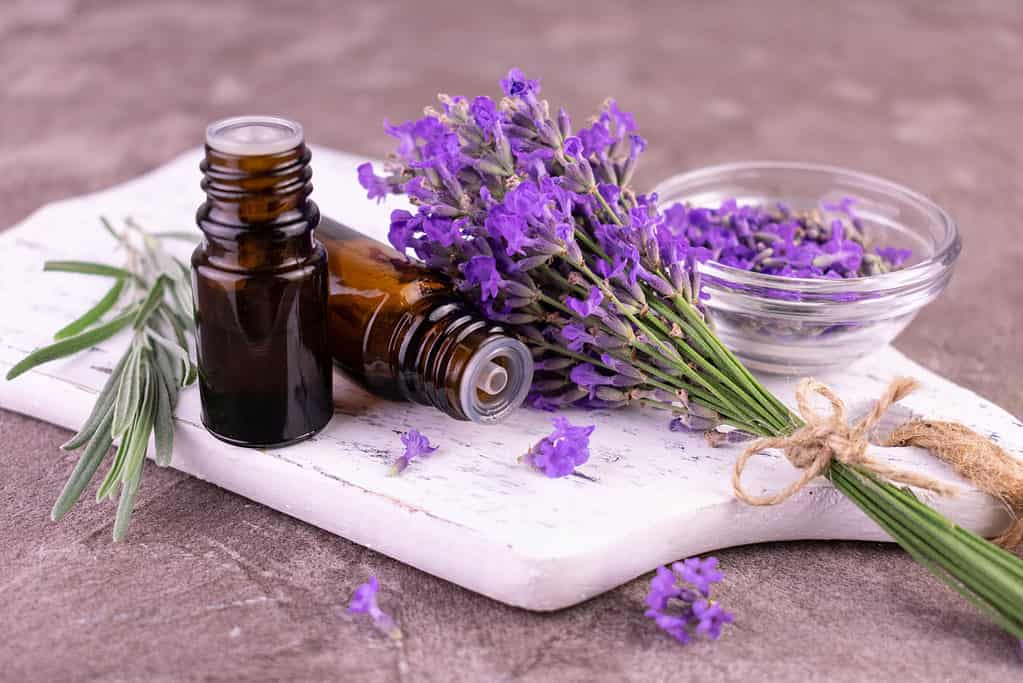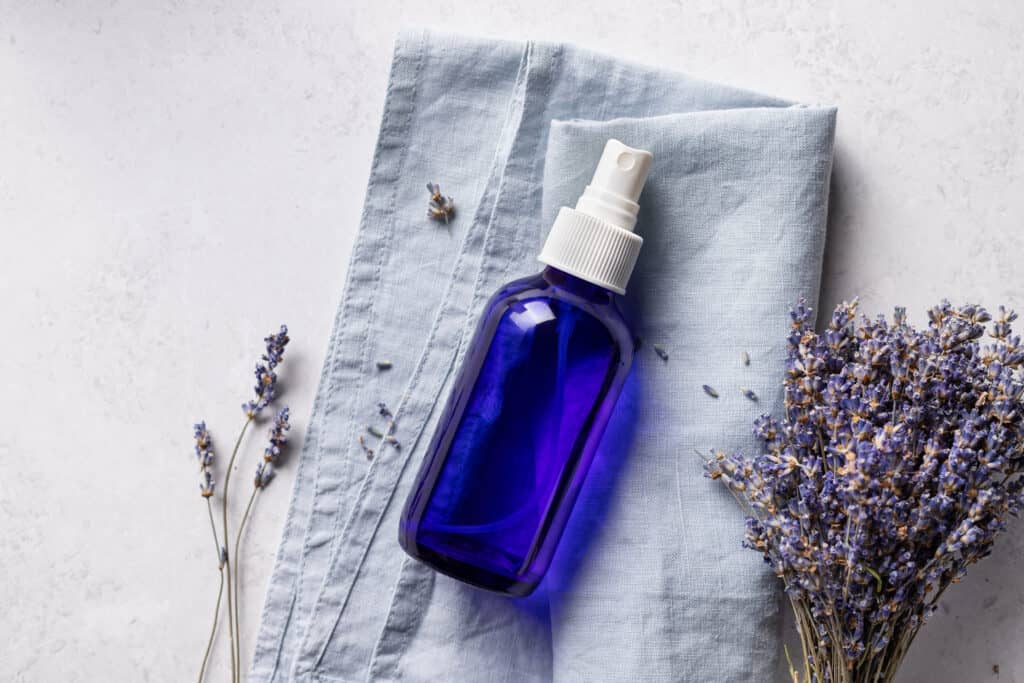With the continued popularity of the essential oils industry, the “magical” lavender plant has made new forays into personal use. Many of us use the aroma to soothe sinuses, clean bathrooms, induce sleep, and provide an aura of calm. But those of us with pets have to be careful what kinds of scents and products we use around the house. If you use natural products for cleaning or aromatherapy, you might wonder if lavender is safe for dogs.
Let’s take a look at when and where lavender may be used around the pooch, if at all. And how to still benefit from the plant for self-care even if Fido can’t enjoy it safely.
What is Lavender?

This purple flower has taken the healthcare and cosmetics world by storm. The plentiful nutrients and sweet aromas draw manufacturers of makeup, skincare lines, perfumes, and doctors to use the amazing plant. But can you safely give lavender to your dog for maladies?
©Kalina Georgieva/Shutterstock.com
A perennial herbaceous plant, lavender comes in many varieties and several species. Common species include Lavendula angustifolia and Lavandula officinalis. Some rarer varieties have been hybridized naturally, like Goodwin Creek Lavender, while others have been carefully crafted to improve various qualities of the plant.
This herb is both edible and skin-friendly, meaning folks around the world use the plant in oil form in a variety of ways. The oil is extracted from fresh flowers.
How is Lavender Used?
You’ll find lavender-based products in six categories, traditionally. Most associate the plant to holistic healthcare in one way or another.
Traditional Medicine

Lavender essential oil, dried flowers, and other forms of the plant frequently get combined with other nutrients and herbs to bring healing.
©iStock.com/Olivka888
Traditional medicine has utilized lavender for many centuries for a variety of conditions. Many of these uses have transferred into standard or Western medical practice as well.
Traditional medicine has used lavender for many years in:
- Sleep support and relaxation
- De-stressing
- Pain relief for headaches
- Cleansing
- Wound healing
- Fighting fungal infections
- Muscle and joint pain
Mental and Emotional Healthcare
Because of the relaxation and de-stressing qualities of lavender, the plant is consistently used in supplementation for sleep and self-care aid. This may include teas, gummies, chews, aromatherapy treatments, and many other options.
Studies have shown that the plant’s sweet, earthy aroma also helps mental healthcare in safe, self-administrated settings.
Aromatherapy

Many folks use lavender sprays and oils to soothe anxiety and help induce sleep. Can it work for dogs?
©Mila Naumova/Shutterstock.com
Lavender in the form of essential oils and dried flowers find many uses in aromatherapy treatments. The flower may be hung or placed in the home, used in sleep eye masks, scented candles, soothing teas, oil diffusers, and other means to help with the many stress, sleep, and similar conditions.
Perfumes, Skin Care, and Cosmetics
Because of the soothing nature of the plant, lavender has become a huge component of the skincare and cosmetics industry. The flower makes its way into perfumes, skincare lotions, shampoos, conditioners, makeup, serums, bath oils, soaps, and pretty much anything else you might use on your skin or hair.
Standard Medicine
According to the Cleveland Clinic, lavender’s many known healthcare benefits may be employed by Western medical practitioners both in holistic and standard care. Compounds in lavender include flavonoids, which work to offer both anti-inflammatory and antioxidant actions in the body. Linalool, also found in lavender, reduces blood pressure and anxiety. Uses may include:
- Wound healing
- Sleep therapy
- Pain relief for headaches
- Reduction of inflammation
- Menstrual pain relief
- Antiseptic care
- Relieving colic
- Fighting fungal infections
Floral Design
The lovely purple flowers, of course, have popular use among florists for special occasions and everyday bouquets. The flowers make lovely additions to “get well” gifts and wedding bouquets for their good looks at the sweet, calming aroma they send out.
Is There Any Form of Lavender That’s Safe for Dogs?

You can safely use highly diluted lavender oil for dog paws. But you should never feed them anything containing the flower as it’s toxic to canines.
©Laura Beach/Shutterstock.com
Lavender is toxic for dogs if they consume it. You should avoid using any kind of supplementation or food containing lavender for your dog. You should also skip the aromatherapy when they’re around.
On the other hand, extremely diluted lavender essential oil is safe for dogs as a topical herbal treatment. So, if you’re tempted to soothe your pooch’s woes with some calming lavender essential oils, you should skip it. Instead, dilute the oil first with other dog-safe carrier oils. A few safe choices include:
- Olive oil
- Coconut oil
- Sunflower oil
- Grapeseed oil
- Camellia oil
- Jojoba oil
- Avocado oil
Lavender in diluted forms may actually help your pooch feel better. Shampoos containing the herb can help soothe the skin of dogs with allergies. The scent also helps to keep biting insects away. It’s best to purchase products made for dogs containing lavender, though, rather than making your own. The wrong dilution could wind up irritating your dog’s skin or digestive tract.
What Happens if a Dog Consumes or Inhales Lavender?
Lavender toxicity manifests in unpleasant ways for pooches who inhale or consume the herb. Look for signs of:
- Vomiting
- Bloated abdomen
- Fever
- Loss of appetite
- Inability to pass stool
- Signs of abdominal pain and tenderness
If your furry pal has somehow consumed or breathed in lavender and shows any of these signs, get them to the vet as soon as possible to help prevent worse symptoms.
Thank you for reading! Have some feedback for us? Contact the AZ Animals editorial team.








